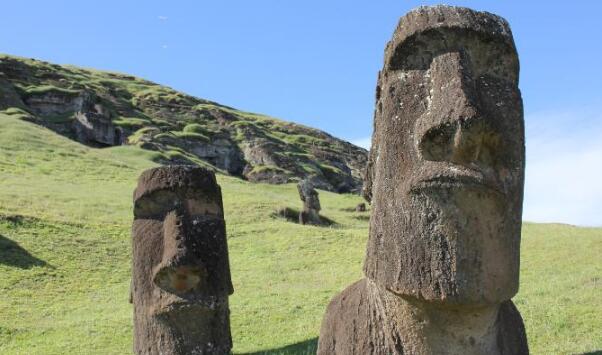New theory paints more sophisticated picture of ancient Easter Island
For decades, mystery has swirled around what happened to the founding population of the remote Easter Island, known for its towering stone statues depicting large carved heads. A long-held theory suggests that after the islanders set up camp and carved the giant statues, they destroyed their own society through infighting and a depletion of natural resources.
But a new study suggests a different scenario entirely, and the islanders could have a more complex history than previously believed.
Many aspects of the island, the statues and the Polynesian seafarers who arrived there 900 years ago have been studied over the years. But a study published Monday in the Journal of Pacific Archaeology uses multiple data sets from recent excavations to provide a better understanding of the society that created the statues and how they were carved.
So the researchers used an unlikely method to study the society and discern what might have happened: a chemical analysis of stone tools used on the statues.
What they learned from excavating four of the statues and the volcanic stone basalt tools used to carve them painted a different picture: a sophisticated and collaborative society.
"The idea of competition and collapse on Easter Island might be overstated," said lead study author Dale Simpson Jr., an archaeologist at the University of Queensland, in a statement. "To me, the stone carving industry is solid evidence that there was cooperation among families and craft groups."

A complex society
Easter Island is 2,300 miles off the coast of Chile. About 900 years ago, the founding population landed on the island, called Rapa Nui in the local language. These Polynesian seafarers came on two canoes and were led by Hotu Matu'a, who would become the island's first chief, according to oral tradition.
The population soared to include thousands of people, and they carved full-body figures, called moai, to represent important Rapa Nui ancestors. There are nearly a thousand statues, many buried up to their heads due to the passage of time. The largest statue is over 70 feet tall.
Their sheer size and number is indicative of a complex, sophisticated society, according to the researchers.
"Ancient Rapa Nui had chiefs, priests, and guilds of workers who fished, farmed, and made the moai. There was a certain level of sociopolitical organization that was needed to carve almost a thousand statues," Simpson said.
During the statue excavations, Jo Anne Van Tilburg, director of the Easter Island Statue Project, and her Rapa Nui excavation team recovered about 1,600 stone tools. They did a close chemical and mass spectrometer analysis of fragments from 17 of the tools, called toki.
"We wanted to figure out where the raw materials used to manufacture the artifacts came from," said Laure Dussubieux, a study co-author and Field Museum scientist, in a statement. "We wanted to know if people were taking material from close to where they lived."
The location is key because there are three sources, or quarries, where the islanders could have gathered material for tools. The basalt quarries cover the size of two football fields. Basalt samples reveal their sources through their chemical elements, which link back to the geology of the site.
"The majority of the toki came from one quarry complex -- once the people found the quarry they liked, they stayed with it," Simpson said. "For everyone to be using one type of stone, I believe they had to collaborate. That's why they were so successful -- they were working together."
Looking ahead
This contrasts with the idea that the residents ran out of resources and fought amongst themselves, the researchers said. But later on, it is believed that the arrival of colonists and the institution of slavery decimated the population.
"There's so much mystery around Easter Island, because it's so isolated, but on the island, people were, and still are, interacting in huge amounts," Simpson said. "There are thousands of Rapa Nui people alive today -- the society isn't gone."
But the researchers also urge caution and believe that this study is just the beginning, laying the groundwork for more research.
"The near exclusive use of one quarry to produce these seventeen tools supports a view of craft specialization based on information exchange, but we can't know at this stage if the interaction was collaborative," Van Tilburg said. "It may also have been coercive in some way. Human behavior is complex. This study encourages further mapping and stone sourcing, and our excavations continue to shed new light on moai carving."

